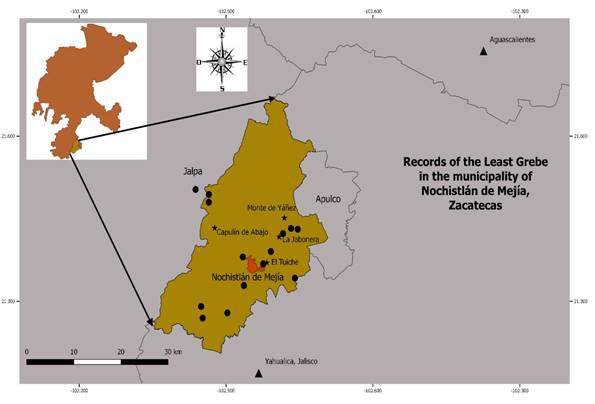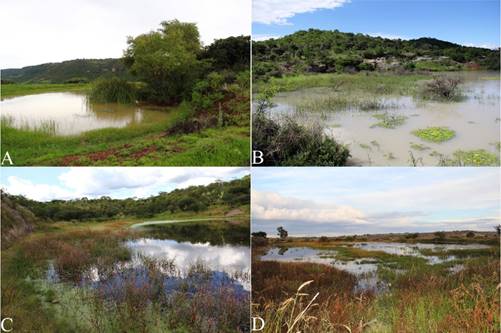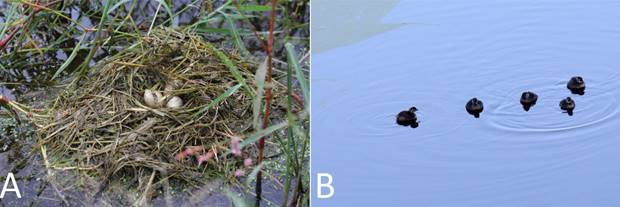Editor asociado: Leonardo Chapa Vargas
Introduction
The Least Grebe (Tachybaptus dominicus) is a freshwater bird species that ranges from southern Texas to northern Argentina (Storer 2011). It inhabits temporary or permanent water bodies, from small ponds to lakes, especially those with vegetated edges for cover (Howell and Webb 1995, Storer 2011), but it can also nest on small artificial ponds if enough prey is available (Brinkley and Humann 2001, Ortega-Álvarez 2013). In México, it is found mainly in lowlands along both Pacific and Gulf coasts, from Sonora and Tamaulipas to Chiapas and Yucatan Peninsula, respectively (Howell and Webb 1995), with records on Baja California Sur (Llinas and Jiménez 1997, Carmona et al. 1999), central México (Ortega-Álvarez 2013, eBird 2012), and northern México (e.g. Coahuila, Durango; McCormack et al. 2007); in recent years, it has been recorded more frequently in north-central México (e.g. Aguascalientes, Jalisco, eBird 2012).
In México, the Least Grebe is at the category of special concern (SEMARNAT 2010), and owing to its frequent use of artificial ponds, human activity could have a negative impact on this species. Least Grebe breeds year-round in the tropics, and nesting records in unusual areas of México have been reported in the state of México, central México (Storer 2011, Ortega-Álvarez 2013). In addition, McCormack et al. (2007) recorded three pairs of Least Grebe in Coahuila as possible breeders in human-made reservoirs, but with no breeding records confirmed. In the states of Aguascalientes and Jalisco, young Least Grebe have been observed (eBird 2012), but there is a lack of information about its local behavior and dispersal. In this paper, I report information about records, breeding sites, and behavior of this species in the municipality of Nochistlán de Mejía, Zacatecas.
Methods
From September 2011 to December 2016, I carried out bird surveys randomly in the municipality of Nochistlán de Mejía, southwestern Zacatecas (Figure 1). Vegetation types were: cactus-acacia-mesquite scrub, oak and pine-oak forests, tropical deciduous forest, induced grasslands, and artificial ponds. Distance traveled by day varied from 500 m to 7 km, on foot, with an average of 4 km, and it included roads and areas within the vegetation types surveyed. I visited permanent and temporal streams and artificial ponds looking for waterbirds using 7 x 35 mm binoculars. Where Least Grebes were detected, I visited the same sites some weeks or months later after the first sighting to corroborate if they were still present in the pond. Human activities and cattle grazing were recorded in the area surrounded the artificial pond.

Figure 1 Study area. Stars represent the four sites where Least Grebe were observed breeding (Capulín de Abajo, Monte de Yáñez, El Tuiche and La Jabonera). Dots represent additional sites where the Least Grebe were recorded in the municipality. Diamond represents a record in the municipality of Jalpa, and triangles represent the nearest sites in Jalisco and Aguascalientes where the Least Grebe has been recorded.
Results
Breeding records
In May, July, September, and October 2014 four breeding sites of the Least Grebe in the municipality of Nochistlán de Mejía, Zacatecas, were located in artificial ponds, locally known as “bordos”. At site one, a permanent artificial pond, Rancho Capulín de Abajo (21º25´59˝N, 102º55´24˝O, Datum WGS84; 2297 meters above sea level (masl, Figure 1) on 12 May 2014, four adults and three young were observed in the area. The surrounding vegetation includes oak (Quercus spp.) and second growth vegetation. The height of the aquatic vegetation above the water was 2.5 m and the size of the pond was approximately 55 x 20 m (Figure 2A). There were no signs of cattle in the surrounding area. During visits to the site on 27 June and 8 July 2014 only two adults were seen, with no young. During an additional visit on February 2015 I observed two adults and three young. No other aquatic birds were recorded in the site during these visits.

Figure 2 Breeding sites of the Least Grebe at Nochistlán de Mejía, Zacatecas. A) Capulín de Abajo: Oak and second growth vegetation, B) Monte de Yáñez: Oak and second growth vegetation, C) El Tuiche: Cactus-Acacia-Mesquite scrub and induced grasslands, D) La Jabonera: Cactus-Acacia-Mesquite scrub and corn crops.
At site two, a permanent artificial pond, Rancho Monte de Yáñez (21º27´05˝N, 102º46´51˝O, Datum wgs84; 1994 masl; Figure 1) in 7 July 2014, two adults and three young were observed. The surrounding vegetation includes oak (Quercus spp.) and second growth vegetation. The height of the aquatic vegetation above the water was 1 m and the size of the pond was approximately 170 x 85 m (Figure 2B). There were some cattle grazing in the surroundings. In 12 September 2014 only one adult was seen. The only additional aquatic bird seen during these visits was the Mexican Duck (Anas platyrhynchos diazi).
At site three, a permanent artificial pond, Rancho El Tuiche (21º22´12˝N, 102º49´00˝O, Datum WGS84; 1858 masl; Figure 1), on 4 September 2014, two adults and a nest with three eggs were observed; the eggs were partially covered with plant matter (Figure 3A). The surrounding vegetation includes cactus-acacia-mesquite (Opuntia spp.-Acacia spp.-Prosopis spp.) scrub and induced grasslands. The height of the aquatic vegetation above the water was 1 m and the size of pond was approximately 85 x 45 m (Figure 2C). At the time when the birds were observed there were no signs of cattle. However, approximately two months earlier some cattle were seen, and in 30 June 2014, a single adult was seen in this “bordo”. In 16 September, the three young were recently born, because they were carried on the back of one of the parents. Also, the Mexican Duck was recorded during these visits.

Figure 3 A) Least Grebe nest with three eggs at El Tuiche in 4 September 2014. B) Two adults and three young Least Grebe at El Tuiche in 1 November, age of young approximately 8 weeks.
At site four, a temporal artificial pond, Rancho La Jabonera (21º25´01˝N, 102º47´28˝O, Datum WGS84; 1975 masl; Figure 1), 1 October 2014, two adults and five young were observed. The surrounding vegetation includes cactus-acacia-mesquite (Opuntia spp.-Acacia spp.-Prosopis spp.) scrub and corn crops. The height of the aquatic vegetation above the water was 50 cm and the size of the pond was approximately 85 x 50 m (Figure 2D). The area seemed abandoned and there were no signs of cattle. No other aquatic birds were recorded during this visit.
Behavior
When I approached the artificial pond where adults and young were present, alarm calls were given by one of the parents and all joined and swam to the center of the pond, away from the strangers. Some of the young were not close to the parents during these moments, but with the alarm calls they rapidly swam towards the parents. This behavior was recorded at places where vegetation was not tall or dense enough to serve as cover; on the other hand, grebes swam underwater towards the aquatic vegetation to cover and stay there until disturbance was gone. Only young grebes sometimes showed themselves from time to time, but rapidly hid if they detected any stranger.
At rancho La Jabonera, 1 October 2014, I recorded two adults and five young. I returned to this site at 17 November and only both parents and one young were recorded. Interestingly, at 29 November 2014, approximately three kilometers from this last site, I observed two young Least Grebe and no adults in a different artificial pond, which previously was not occupied by Least Grebes, and probably corresponded the young missing from the artificial pond at rancho La Jabonera. The fact that some young were found alone with no adults in other sites could explain dispersal, something that could ha ppened At Rancho El Tuiche. I found a nest with three eggs at El Tuiche in 4 September 2014, and in 16 September young Least Grebes were carried on the back of one of the parents, which means they had few days after they were born. At 1 November 2014, young at age of approximately eight weeks were seen swimming with the parents (Figure 3B). I visited this artificial pond at 15 November 2014 and only the pa rents and one young were observed. Perhaps two of the three young were eaten by predators, or possibly they left the artificial pond where they were born after a period of nine to 10 weeks, approximately. Future research will clarify age of dispersal in the area.
Discussion
Artificial ponds (“bordos”) are very common in north-central Mexico, and are made by people who have cattle in their properties. Some artificial ponds retain water all-year round, and others just for a few months. Such “bordos” are important sites for migratory waterbirds such as ducks. For instance, in No chistlán de Mejía I have recorded 13 duck species (Pérez-Valadez 2016), but also these “bordos” are important for resident birds such as Mexican Duck (Anas platyrhynchos diazi) (Medina-Torres et al. 2007) which is a protected species in Mexico (SEMARNAT 2010). The fact that the Least Grebe is also found in some of these sites outside its known range could be related to the presence of new suitable feeding and breeding sites (Ortega-Álvarez 2013), or areas in Mexico not yet surveyed intensely. Least Grebes could have an increasing population due to its generalized feeding habits, and high reproductive rate (Storer 2011). On the other hand, human activities such as agriculture, tourism, urban and industrial development have contributed to habitat loss and contamination of wetlands ecosystems, which may explain the expanding of the Least Grebe from the original breeding sites on the tropics (Wilson and Ryan 1997, Aguilar 2003).
Least Grebe is a species that breeds year-round in the tropics (Storer 2011). In Jalisco and Aguascalientes, in areas close to Nochistlán de Mejía, young Least Grebe have been recorded in January, June, October, and December (eBird 2012). I found young Least Grebe in February, May, July, September, October, and November. The nearest sites to Nochistlán de Mejía where the Least Grebe has been recorded are Yahualica, northeast Jalisco, approximately to 16.5 km (Naturalista 2016), and Agostaderito, southwestern Aguascalientes, approximately to 54.5 km (eBird 2012, Figure 1). With respect to young Least Grebe records, they are located in presa Huaxtla, Jalisco, southwestern Nochistlán de Mejía, approximately to 90 km, and at Parque Ecológico El Cedazo, Aguascalientes, northeast Nochistlán de Mejía, approximately to 70 km (eBird 2012).
In Zacatecas, the Least Grebe was not previously recorded until 2012, likely as a consequence of poor avifauna studies in this state (Pérez-Valadez 2016). Since then I have observed this species in different sites within the municipality of Nochistlán de Mejía, and even in some of these sites like Capulín de Abajo they continue breeding. This site has a good aquatic vegetation cover and there is no presence of cattle. On the other hand, I visited El Tuiche and La Jabonera the last months of 2016, when both artificial ponds retain water, and found no young, just two adults at El Tuiche. This could happen as a consequence of human and cattle disturbance. For example, At La Jabonera, cattle increased and aquatic vegetation was reduced by human activity around the artificial pond, with no Least Grebes. In Nochistlán de Mejía, agriculture represents approximately 32.5% of the surface (INEGI 2010), and it continues increasing with cattle grazing, which means that people make more artificial ponds (pers. obs.). Most of the artificial ponds where I recorded Least Grebe corresponded to ponds located in abandoned ranches, where aquatic vegetation prospered, and there were no cattle present in the area.
Least Grebe is a common species in Nochistlán de Mejía; I found it at 18 different sites within the municipality, and recorded it all months of the year in an altitudinal range between 1600 to 2297 meters above sea. Despite I did not carry out surveys in the northern part of the municipality, there are potentially good artificial ponds for the presence of the Least Grebe. As a protected species in Mexico (SEMARNAT 2010), and the fact that until recently has been recorded breeding in Zacatecas, it is important to continue with surveys for a better understanding of the environmental requirements of Least Grebe in this area of Mexico.











 text new page (beta)
text new page (beta)


